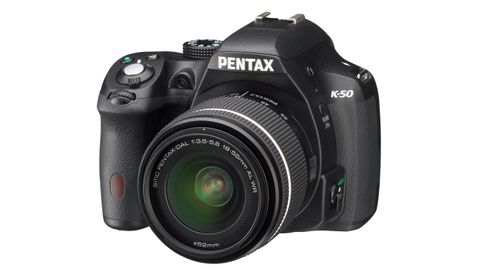Why you can trust TechRadar
As with the K-30, there's a fair amount to like about the K-50 and it does make for a good alternative to the Canon and Nikon traditional go-to cameras. One interesting aspect is the ability to use AA batteries (a lithium-ion battery is included in the box), meaning that if you run out of charge when you're out and about, you should be able to find some spare power pretty easily – something which is particularly appealing to holidaying photographers.
The fact that the body is weather-sealed is also an excellent bonus, especially for those who live in less than arid climates. It's something which elevates it higher than its nearest Canon or Nikon rivals, being something which is usually reserved for cameras much higher up in the line.
Using the camera is a pretty pleasant experience, with the arrangement of buttons and a textured, chunky grip making sense a lot of the time. For instance, having one dial to control shutter speed and another for aperture feels like a very natural way to work for those that like to use fully manual mode.
It's very useful that the K-50 shoots in DNG raw format, rather than a proprietary system, meaning you're not restricted by a proprietary raw format. This is good news for those already using something like Photoshop as they can get going straight away. It's just a shame you can't shoot digital filters in this raw format, as that would have made a lot of sense.
Having a 100% field of view viewfinder is pretty unusual for a camera of this price, but it's a welcome feature that we've seen on a lot of Pentax DSLRs. In practice, the gap between a 97 or 98% and 100% device may not sound like a lot, but it can be the difference between the perfect composition and a near miss, so we're big fans of that particular element.
On the other hand, it's a shame not to see an articulating or tilting screen on this camera. It really does help when trying to compose from awkward angles, as well as being useful for video recording.
We liked
Happily, there's quite a lot to like about the K-50, but probably the best thing is the weatherproofing. It's refreshing to see a camera at this end of the market that can be used in all weather conditions, making it appealing to those that want something robust that can be used as an everyday camera for family and holiday photography.
We disliked
We'd like to see an articulating screen here to help with those awkward compositions. It'd be nice if the kit lens wasn't quite so noisy either.
Final Verdict
As the biggest selling point of the camera is its weather-proofing credentials, to get the most from the K-50, you'd be better off investing in the 18-135mm f/3.5-5.6 WR (weather resistant) lens to make the whole package more durable. That lens also gives you more flexibility and is overall a better performer than the 18-55mm lens which is supplied as the standard kit. Unfortunately, that does mean a big increase in the price, so if you're on a tight budget that's bad news.
Happily, image quality is very good, and it's great to have a good amount of flexibility with raw files to work with, while the JPEGs straight from the camera are also very pleasing.
Overall, this is a good purchase for those looking for their first DSLR and want something a little bit rugged that can cope with a wide variety of different shooting conditions. If you have no particular affiliation to the Canon and Nikon standards here, definitely think about the K-50, if for the weather-sealing alone.
Amy has been writing about cameras, photography and associated tech since 2009. Amy was once part of the photography testing team for Future Publishing working across TechRadar, Digital Camera, PhotoPlus, N Photo and Photography Week. For her photography, she has won awards and has been exhibited. She often partakes in unusual projects - including one intense year where she used a different camera every single day. Amy is currently the Features Editor at Amateur Photographer magazine, and in her increasingly little spare time works across a number of high-profile publications including Wired, Stuff, Digital Camera World, Expert Reviews, and just a little off-tangent, PetsRadar.


